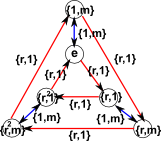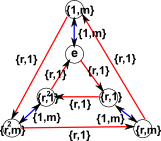Abelian Groups are groups which commute (ab = ba)
The Fundamental Theorem of Abelian Groups
Every finite abelian group 'Ab' is isomorphic to a direct product of cyclic groups, That is:
Ab Cn1
Cn1 Cn2
Cn2 …
… Cnm
Cnm
Cyclic Groups
The properties of cyclic groups are discussed on this page and listed on this datasheet so we will just summarise here:
| Cayley Table |
Cayley Graph |
Cyclic Notation |
| |
1 |
a |
b |
c |
... |
n |
| 1 |
1 |
a |
b |
c |
... |
n |
| a |
a |
b |
c |
... |
n |
n-1 |
| b |
b |
c |
... |
n |
n-1 |
|
| c |
c |
... |
n |
n-1 |
|
|
| ... |
... |
n |
n-1 |
|
|
|
| n |
n |
n-1 |
|
|
|
|
|
 |
(1,2,3..n) |
| Group Presentation |
Group Representation |
|
| <a | an=1> |
| 0 |
0 |
… |
0 |
0 |
1 |
| 1 |
0 |
… |
0 |
0 |
0 |
| 0 |
1 |
… |
0 |
0 |
0 |
 |
 |
 |
 |
 |
 |
| 0 |
0 |
… |
1 |
0 |
0 |
| 0 |
0 |
… |
0 |
1 |
0 |
|
|
Products of Cyclic Groups
Commutivity in Caley Diagrams
Commutivity in Multiplication Tables
Commutivity in Cyclic Notation
If we are multiplying a 3 element cycle by a two element cycle we number the elements in the 2×3 rectangle:
we then create 2 permutations, one from the rows and the other from the columns:
<(1 2 3)(4 5 6),(1 4)(2 5)(3 6)>
Simarly for n×m multipication:
| 1 |
2 |
… |
n |
n+1 |
) |
 |
 |
 |
 |
 |
 |
| 1 |
2 |
… |
n |
n+1 |
) |
Generating a Abelian Group using a Program
We can use a computer program to generate these groups, here I have used Axiom/FriCAS which is described here.
(1) -> )r axiom/abelian
)set output algebra off
)set output mathml on
C2 := FiniteGroup(2,[[1,2],[2,1]],["a","b"])
Type: Type
AB6 := directProduct([[1,2,3],[2,3,1],[3,1,2]],["1","2","3"])$C2
Type: Type
toTable()$AB6
| a1 |
a2 |
a3 |
b1 |
b2 |
b3 |
| a2 |
a3 |
a1 |
b2 |
b3 |
b1 |
| a3 |
a1 |
a2 |
b3 |
b1 |
b2 |
| b1 |
b2 |
b3 |
a1 |
a2 |
a3 |
| b2 |
b3 |
b1 |
a2 |
a3 |
a1 |
| b3 |
b1 |
b2 |
a3 |
a1 |
a2 |
Type: Table(6)
setGenerators([false,true,false,true,false,false])$AB6
Type: Void
PAB6 := toPermutation()$AB6
<(1 2 3)(4 5 6),(1 4)(2 5)(3 6)>
Type: PermutationGroup(Integer)
permutationRepresentation(PAB6,6)
| [ |
| 0 |
0 |
1 |
0 |
0 |
0 |
| 1 |
0 |
0 |
0 |
0 |
0 |
| 0 |
1 |
0 |
0 |
0 |
0 |
| 0 |
0 |
0 |
0 |
0 |
1 |
| 0 |
0 |
0 |
1 |
0 |
0 |
| 0 |
0 |
0 |
0 |
1 |
0 |
|
, |
| 0 |
0 |
0 |
1 |
0 |
0 |
| 0 |
0 |
0 |
0 |
1 |
0 |
| 0 |
0 |
0 |
0 |
0 |
1 |
| 1 |
0 |
0 |
0 |
0 |
0 |
| 0 |
1 |
0 |
0 |
0 |
0 |
| 0 |
0 |
1 |
0 |
0 |
0 |
|
|
] |
Type: List(Matrix(Integer))
(7) ->
|
where:
- The points of the permutation are numbered 1..n
- The elements of the group are named: "i" for the identity, single letters "a","b"... for the generators, and products of these.
- numbers in brackets are points of permutations represented in cyclic notation.
- abelianGroup[1] is not really valid and the results for this case are nonsense.
- The Axiom/FriCAS program can't work in terms of the Cayley table, so I have added my own code to do this.
![]() Cn1
Cn1![]() Cn2
Cn2![]() …
…![]() Cnm
Cnm


